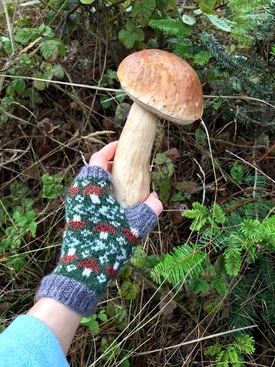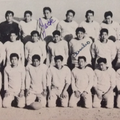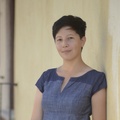On still-damp, foggy mornings after the rain has cleared, Sayuri Shinya and her husband drive from their home in the San Francisco Bay Area and into the woods, looking for mushrooms. Shinya began forging five years ago, when she met her husband, who grew up in Germany and has hunted for mushrooms since childhood.
“At first, I thought it was weird,” she told me. “I was like, mushrooms, really? Foraging is not something you hear about all the time. Mushrooms sound like, you could buy that in the store, right? But the kinds we pick, they're not like button mushrooms; they're not something you can grow. That's what makes it so much more difficult and more expensive and just worth it.”

I met Shinya on Instagram, where we both post photos of our knitting projects. Along with colorwork hats and cabled sweaters, she has also posted homemade shiratama and Japanese pudding, farmer’s market stone fruit hauls, lichen harvested for fiber-dyeing, and mushrooms. The mushrooms are mostly frilly chanterelles and stocky porcini, with the odd flared pig’s ear and poisonous, glowing jack o’lantern (not for eating but for steeping to make dye). Though she and her husband occasionally sell mushrooms to restaurants when they have a surplus, they mostly give them to family and friends or cook them for themselves. In the mushroom off-season, they forage for other plants, like huckleberries and loquats.
Shinya, who moved to California from Tokyo at the age of 12, works as a chemist in a water treatment lab. Working indoors all day, she loves spending time outside and using her creativity to cook, knit, and cross-stitch (recently a porcini-patterned wall hanging). I talked with her by video about falling in love with foraging, tips for beginners, and her comfort foods.
Do you remember your first foraging trip?
There's a state park up north from where I live in Sonoma County called Salt Point State Park, and it's one of only three or four state parks in the Bay Area that allow foraging. So we went up there, and the first couple times we got—they call it "getting skunked," which means you don't find anything. You drive all the way out there, it's about a two-hour drive, you go there, you're walking all day, and you don't find a single mushroom. And you don't know, Is it the place or the timing? What am I doing wrong? You just have to keep going and just put time into it.
So we kept going until we finally hit the jackpot, and that moment was so addicting. You always remember the first mushroom that you found yourself. It's a really exciting feeling. It feels like treasure-hunting. And once you get to know where they grow and you start marking the map—like I have a GPS app on my phone—and you start tagging the locations, you create your own treasure map that you can go back to year after year.
What kind of mushroom did you find on that first trip?

In the beginning, we were mostly looking for porcini mushrooms, which are considered "king mushrooms." They're really satisfying because they grow really big—they can be humongous. So when you find one, it's just like, wow. It jumps out at you, almost. So we started with porcini, and then we started seeing other mushrooms, like chanterelles and matsutake. The matsutake that grows around the Bay Area is a little different from the one in Japan, but it's still really tasty. You can't mistake that one because of the fragrant aroma.
You've been finding a lot of morels lately too, right?
Yes, so morels we've just started this year. They grow in a completely different place from all of our previous mushrooms, so we started going to the Sierras. They tend to grow in burned areas, so if there was a forest fire in the summer, then the next spring would be a good time to look for them. Morels really like disturbed soil, so it doesn't even have to be a fire—it could be from logging, or some people even find them in their backyards.
What are some of your favorite ways to prepare the mushrooms you forage?
With porcini, I like frying them up with butter and salt and pepper, and a good slice of bread. I feel like that's the best way to do it. A lot of people have other ideas. There are tons of recipes online. I also like making a cream sauce with heavy whipping cream. The flavor really comes out with that sauce.
Do you remember eating dishes with mushroom in them when you were growing up?
Yeah, it wasn't like my favorite thing back then, but I do love matsutake. Every fall, I just crave it. It's gourmet, it's very expensive, but it's a really nice treat in the fall. We ate matsutake gohan. We also just grilled it—you can actually do it whole. You put it on the grill and then you eat it with ponzu, and it's the best. With mushrooms, simple is best. You don't want to overwhelm them with other flavors.
So you have this map that you've been developing over time—do you have a community that you share tips with? Is the community really into sharing knowledge, or do you get your own and keep it a secret?
We actually do quite a lot of detective work. We rely on social media. There's a page on Facebook called Mushroom Hunters of California, and it's a really great place because people are willing to share—not like GPS coordinates or anything, but the general location, so you get an idea of what's growing where. Instagram is also great. I usually look for either locations or hashtags, like #porcini, because the first porcini of the season, that's really hard, the timing. They like a lot of rain, so it's usually in the fall or winter. But it's just so far for us to get to where they grow, I usually go on Instagram and see if people have found anything, and if we see anything, that’s when we go.
But as far as sharing locations, mushroom hunters that are really into it, they don't share. This is like their spot. I've heard of people who, if they take their friends, they might blindfold them so they don't find out exactly where they're going. People are pretty serious about their locations because, I mean, they put a lot of time and effort into discovering these places, so they don't want to give it away.
I know you mentioned that different mushrooms like different kinds of environments. Do they like different climates too? Do they have different seasons?
Mushrooms mostly like moisture. So in Northern California, it would be after the rainy season. There are exceptions, and morels actually grow all over the country. They’re actually a big thing in the Midwest. Mushrooms also have an association with certain trees. For porcini, at least in Northern California, on the coast, they like pine trees. So that's the first thing you look for: Is there a pine tree? If not, then you're not going to see a porcini.
When you're looking for them, do you have to sift through ground cover, or can you just spot them without having to move anything?
It depends on what kind. So porcini, they stand out because they get really big. Chanterelles too—they’re yellow and they tend to be pretty big too. But sometimes you might find a chanterelle in like, a poison oak bush. If you're dedicated, you might go and get in there. I think some people would. I might leave that one alone. There's a mushroom called the black trumpet. They're completely black mushrooms, so they're really hard to see. For those, I often have to really look on the ground. Often I just find them by mistake. I just happen to look there or I drop something on the ground and when I look down, I find them.
Have you ever had a scary experience with a poisonous mushroom, and how do you prevent that from happening?
That's the most important thing in mushroom hunting: don't eat a mushroom you don't know. If you're not 100% sure what it is, don't eat it. What's good about porcini, for example, is there are no lookalikes that are deadly, so it's pretty safe. But chanterelles have a poisonous lookalike. It won't kill you, but it will make you sick. It depends on the mushroom, so you really have to look at all the features and make sure you're picking the right kind.
We never pick ones that have a deadly lookalike, and there are ones that will kill you if you're not careful. There's one called coccora that is similar to the death cap, which is deadly. We've come across both of those, and my husband just refuses to pick them. Which is good. That's probably how we should do it. We don't want to be too confident.
People ask me all the time, how do you know if a mushroom is edible? But I think at first, if you really want to get into it, it's best to go with someone who knows where to look and when to go and how to distinguish the characteristics of different mushrooms. It's hard to get started on your own.
I’m sure you also have to be careful about where you forage so that you’re not wandering onto private property. What is a good way to make sure you’re in the right place?
I've heard of people not caring and just trespassing, and I don't recommend that at all. I would look up what places are safe to forage around where you are. We definitely look that up. They also give you a daily limit of how much you can forage, like a gallon or ten pounds a day or something. And sometimes you run into rangers and they do check, so if you have too much, they might fine you or take your collection. You have to be careful with that.

Do you have a big Japanese American community where you live? Is that something that is important to you?
I don't really have a community here, actually. I have friends that are Japanese, and I do tend to feel closer to some of my Japanese or Japanese American friends. We just have so much more in common. I've been here for more than half my life, but I still feel very Japanese, and that is my identity. My parents are still there, so I go once per year. Even the kind of cooking I do, I cook a lot of Japanese food. I think just growing up with it, I love all the Japanese flavors.
What are some of your biggest comfort foods?
I love natto. People think it's gross—the texture and the flavor—but I love that stuff. I eat a lot of fish that I cook on a fish grill. There's a website called Cookpad. It's a Japanese recipe website where people post their recipes, and you can make it and report back and say what you think of it. It's probably the biggest cooking website in Japan, and you can subscribe from here in America.
Are you totally fluent in Japanese, reading and writing?
Yeah, I am. But I feel like my Japanese is getting worse, so I'm trying to read more Japanese books and trying to watch—Netflix now has all these Japanese shows, like Terrace House. That’s my guilty pleasure. I clearly don't know anything about dating life in Japan, so that's interesting to me, the dynamics of how people interact with each other. And it makes me homesick because they go to all these restaurants and take trips.
Do you and your husband have a lot of conversations about your cultural differences?
Yeah, we do tend to talk about that. It's funny because he's from Germany, I'm from Japan, and we actually have a lot in common, surprisingly. Germany and Japan are very different places, and yet I feel like our values are the same, and together we're living in America, so we tend to make fun of Americans together. And we both love foraging. It's a shared hobby that is really great to do together, and not only that, but we get to go outside. We love hiking—that's how we met, through hiking and backpacking. So it's still an active hobby, and just being in the woods, even if you don't find any mushrooms, it feels really great.
* * * * *
If you’re interested in learning how to forage, here are two resources Sayuri Shinya recommends:
• FallingFruit.org—an interactive map for urban foraging
• Mushrooms Demystified, by David Arora—an encyclopedia of mushrooms and their history
* Author's note: This interview has been edited for length and clarity.
© 2019 Mia Nakaji Monnier






